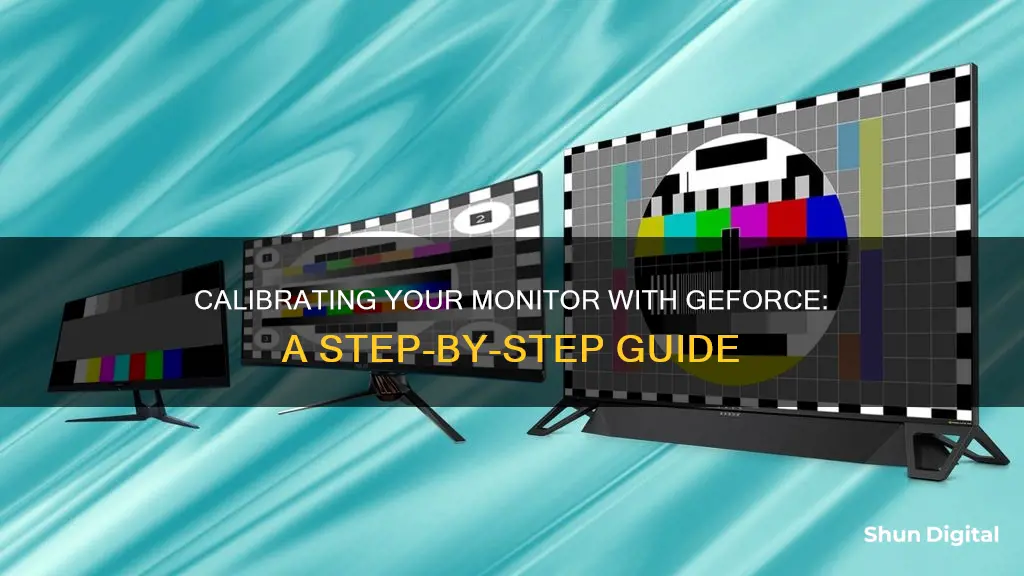
Calibration is a subjective process as our eyes and brains can perceive colour incorrectly. The quality of your monitor and the panel technology it uses will also limit your calibration results. Before you start, back up your old settings and prep your system and room. Install the latest NVIDIA display drivers, set your screen resolution to its native resolution, and let your monitor warm up for 20-30 minutes. Eliminate any glare from windows or artificial lights, but keep the lighting bright enough that you can see your keyboard and surroundings.
Next, correct your viewing position. All monitors have a listed Viewing Angle, but the quality of some monitors can drop drastically when you move off-centre. Switch your position so you're directly in line with your monitor, with the entirety of the screen in your field of view.
Now, you can start tweaking your settings. Use professional reviews as a starting point and install ICC profiles. You can then modify each monitor's settings using their On-Screen Displays (OSD). You can also tweak with free tools and tests, such as the Calibrate display tool in the Advanced tab of the Color Management application.
| Characteristics | Values |
|---|---|
| Viewing Angle | Should be clear and usable |
| Viewing Position | Permanently switch to a position in line with the monitor |
| Lighting | Eliminate glare, but keep the room bright enough to see keyboard and surroundings |
| Calibration Tools | Use professional reviews as a starting point, e.g. TFTCentral, Display Lag, and Prad |
| Calibration Devices | Datacolor's Spyder4, Pantone's ColorMunki, or x-Rite's i1Display Pro |
| Calibration Software | Windows' Display Color Calibration tool, Nvidia Control Panel, or AMD Radeon Settings |
What You'll Learn

Back-up old settings
Before you calibrate your monitor, it's a good idea to back up your old settings. That way, if you don't like the new settings, you can always revert to your old ones.
To back up your old settings, go through your monitor's menus, Windows' options, and the NVIDIA Control Panel. Jot down any old settings and changes you've made in the past. You can also take screenshots of your current settings so you have a visual reference to work from.
If you're using Windows 11, it should automatically detect your monitor's correct colour profile and apply it. However, if the colours still don't look right, you can update to the right colour profile in Color Management in Windows 11. You may first need to download the correct colour profile drivers from your monitor manufacturer's website.
If you're using an older version of Windows, such as Windows 7, you can use the monitor colour calibration utility built into the operating system. This will allow you to tweak your colour settings to ensure your photos and videos are represented accurately on your monitor.
Additionally, if you have an Nvidia graphics card, you can open the Nvidia Control Panel and select "Adjust Desktop Colour Settings". Then, raise the slider for Digital Vibrance to about 65. This should make the colours on your display look richer, brighter, and cleaner.
Choosing the Right-Sized Drawing Monitor for Your Needs
You may want to see also

Prep your system and room
Before you start calibrating your monitor, there are a few things you need to do to prepare your system and the room you're working in. Here's a step-by-step guide:
- Install the latest NVIDIA display drivers: Go to GeForce.com and install the latest display drivers for your NVIDIA graphics card. This will ensure that you have the most up-to-date calibration tools and features.
- Set your screen resolution to its native resolution: Right-click on your desktop and select "NVIDIA Control Panel". Navigate to the "Change Resolution" tab and select the resolution that matches your monitor's native resolution, such as 1920x1080 on a 1920x1080 monitor. This ensures that your monitor is operating at its full potential.
- Let your monitor warm up: Allow your monitor to warm up for 20-30 minutes before calibrating. This is important because it ensures that your monitor is operating at its full capabilities and gives you accurate readings during the calibration process.
- Eliminate glare and adjust lighting: Eliminate any glare on your screen from windows or artificial lights. Adjust the lighting in the room to a level that allows you to see your keyboard and surroundings clearly. If your screen is often affected by glare, consider ways to reduce it permanently, such as adjusting the position of your monitor or using curtains or blinds.
- Correct your viewing position: Ensure that you are sitting directly in front of your monitor, with the entire screen in your field of view. This is important not only for your calibration but also for your posture and eye strain.
- Use professional reviews as a starting point: Websites like TFTCentral, Display Lag, and Prad offer detailed monitor reviews and recommended settings. You can use these as a starting point for your calibration, and in some cases, you may not need to make any further adjustments.
By following these steps, you will have your system and room ready for monitor calibration. Remember that calibration is a subjective process, and you may need to make adjustments to find the settings that work best for you.
Finding Wallpaper Size for a Three-Monitor Setup
You may want to see also

Correct your viewing position
Correcting your viewing position is an important step in the process of calibrating your monitor. All monitors have a listed Viewing Angle, which is the angle at which the picture is clear and usable. However, the quality of some monitors can drop when viewed from off-centre. Therefore, to ensure you have the best possible picture and can calibrate your monitor correctly, adjust your viewing position so that you are directly in line with your monitor, with the entirety of the screen in your field of view. This will not only ensure an optimal viewing experience but also help prevent neck and back problems, especially as you get older.
It is worth noting that even after adjusting your viewing position, the quality of your monitor and the panel technology it uses will impact your viewing experience. For example, IPS panels typically offer superior viewing angles and colours, while TN panels are more responsive and less prone to motion blur. Additionally, the results of your calibration will also depend on the quality of your monitor. Thus, it is important to consider the characteristics of your monitor when calibrating it to achieve the best possible viewing experience.
Monitoring Salesforce Performance: Strategies for Success
You may want to see also

Use professional reviews as a starting point
Calibrating your monitor can be a tricky process, but there are a few steps you can take to ensure you get the best results. One of the best ways to start is by using professional reviews as a starting point. Websites like TFTCentral, Display Lag, and Prad offer detailed monitor reviews and their editors often provide recommended monitor settings and ICC colour management profiles. These settings are generated from professional-grade calibrators and can be a fantastic starting point for your own personalized settings. In many cases, you may find that they are good enough to use without any further tweaking.
Here's a step-by-step guide on how to use professional reviews to calibrate your monitor:
Step 1: Locate Settings and Profiles
Start by checking the TFT Central Database for settings and profiles specific to your monitor. If you can't find what you're looking for, move on to Display Lag and Prad's reviews. If you're still having no luck, try looking on the manufacturer's support page for ICC profiles or try a generic Google search using the term "calibration". If that doesn't yield any results, you may need to skip this section and spend some time in calibration apps.
Step 2: Install the ICC Profile
Once you've located the appropriate settings and profiles, it's time to install the ICC profile. Copy the downloaded file to the following location on your computer: C:Windowssystem32spooldriverscolor. Then, run colorcpl.exe to open the Color Management window. Alternatively, you can navigate to Color Management in the Control Panel.
Step 3: Select "Use My Settings for This Device"
In the Color Management window, tick the "Use my settings for this device" checkbox.
Step 4: Add the Relevant Profile
Click "Add" and locate the relevant profile. If you can't find it, select "Browse" and navigate back to C:Windowssystem32spooldriverscolor.
Step 5: Set as Default Profile
Your new profile will now appear in the window under "Profiles associated with this device". If there is more than one profile, click on the new profile and set it as the default.
Step 6: Access Advanced Settings
Click on the "Advanced" tab and then click on "Change system defaults".
Step 7: Enable Windows Display Calibration
In the Advanced settings window, click on the "Advanced" tab again and tick the "Use Windows display calibration" checkbox.
Step 8: Repeat for Additional Monitors
If you have multiple monitors, simply repeat the process for each additional monitor.
Step 9: Close the Color Management Window
Once you've completed the above steps, close the Color Management window(s).
Step 10: Modify Monitor Settings
Finally, modify each monitor's settings using their On-Screen Displays (OSD). Keep in mind that some OSDs can be unintuitive, so it's recommended to keep the manual handy for reference. If your panel is particularly advanced, you may be able to create multiple profiles or presets and tweak power user settings to give you greater control over the picture. If you're unsure about a particular setting, don't hesitate to consult the manual or seek help online.
Using professional reviews as a starting point can save you a lot of time and effort in calibrating your monitor. By following the steps outlined above, you'll be well on your way to achieving the perfect calibration for your monitor.
Blind Spot Monitor: Is it a Feature of NX F Sport?
You may want to see also

Calibrate brightness, contrast and colour settings
Calibrating your monitor's brightness, contrast and colour settings can be done in a few different ways, depending on your preferences and budget. Here are some methods to help you get the best viewing experience:
Using Windows or MacOS Built-In Calibration Tools:
- Windows 11, 10, and earlier versions offer built-in calibration utilities that can significantly improve your monitor's image quality. To access this feature in Windows 11, simply type "calibrate" in the search box and select "Calibrate display colour". Follow the on-screen instructions, and adjust your gamma, brightness, contrast, and colour settings.
- MacOS users can open System Settings and navigate to the Color tab in the Displays menu to access similar calibration options.
Adjusting Brightness and Contrast:
- The brightness and contrast settings control how your screen displays tones at different brightness levels.
- When adjusting brightness, ensure that you don't turn it down too far, as this can cause eye strain and loss of detail in dark areas of games, movies, and photos.
- To calibrate brightness, use a near-black gradient test pattern and adjust the setting until the 17th step disappears and then go back one step.
- For contrast, use a similar approach by displaying different gradient patterns. Adjust the contrast until you can see some detail in the steps up to 234, with the last few steps being very faint.
Using Online Test Images:
- Websites like Lagom offer LCD test images for contrast, sharpness, and gamma that can help you fine-tune your monitor's settings.
- For contrast, view the Lagom LCD contrast test image and adjust your monitor's contrast setting until you can see all the bars on the test image.
- For gamma, use the Lagom LCD gamma test image and adjust your monitor's gamma settings until the image indicates a gamma value of 2.2.
Using Professional Calibration Tools:
- If you're looking for a more precise calibration, consider investing in a professional calibration tool like a colorimeter. These tools can be expensive, but they provide objective measurements to ensure accurate colour representation.
- Options include Datacolor's SpyderX Pro, X-Rite's i1Display Studio, and Calibrite's i1Display Pro.
- These tools come with software that guides you through the calibration process and creates a custom display profile for your monitor.
Monitoring ChatGPT Usage: Strategies for Tracking Activity and Performance
You may want to see also
Frequently asked questions
The first step is to back up your old settings. Go through your monitor’s menus, Windows’ options, and the NVIDIA Control Panel, noting down any changes you’ve made in the past. This way, you can revert to your old settings if you’re unhappy with the new results.
Install the latest NVIDIA display drivers from GeForce.com, set your screen resolution to its native resolution, and let your monitor warm up for 20-30 minutes to ensure it's operating at full capacity. In your room, eliminate any glare from windows or artificial lights, but keep the lighting bright enough to see your surroundings.
All monitors have a listed Viewing Angle, but the quality can drop when you move off-centre. To ensure the best picture and effective calibration, position yourself in line with the monitor, with the entire screen in your field of view.
In the NVIDIA Control Panel, you can modify the appearance of video content and the desktop. Right-click on your desktop, select "Nvidia Control Panel", click on the “+” sign under “Display”, and select “Change Resolution”. Choose your display's maximum resolution from the scrollable menu, then select the highest refresh rate available.
Windows has a built-in tool for this. Go to the Start Menu, type in "Control Panel", click on the Color Management icon, and navigate to the Advanced tab. Under “Display Calibration”, choose “Calibrate display”. Windows will then guide you through adjusting your gamma, brightness, contrast, and colour balance.







